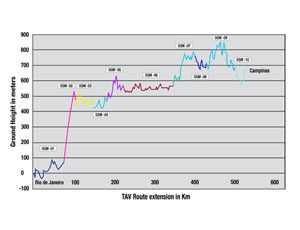Rio de Janeiro is pushing for high-speed-rail service in time for the 2014 Olympic Games. The Brazilian government plans to issue a concessionaire contract in May for a 510.7-kilometer-long high-speed-rail system to link the cities of Campinas, São Paulo and Rio de Janeiro. Construction costs are estimated at $19.3 billion, and the term of the concession is 40 years.
The Trem de Alta Velocidade (TAV) line will include nine stations, 90.9 km of tunnels and 107.8 km of bridges. Public consultations have been completed, and the government is waiting for Federal Audit Court approval of the project. The following firms have already expressed interest in forming consortiums to participate in the tender: France (Alstom), Germany (Voith Siemens), Italy (Ansaldo Breda), Korea (Hyundai), Japan (Mitsubishi, Kawasaki, Toshiba and Hitachi) and the Chinese company China Railway Materials (CRM). In Brazil, the Bertin Group is contemplating teaming with Samsung and Hyundai.
The project will be financed by a specially formed company called TAV Brasil. The government and third parties will also participate. The Brazilian Bank of Economic and Social Development, the main funding agency controlled by the Brazilian government, will finance $11.6 billion. The government also will spend $1.2 billion for right-of-way acquisitions, in addition to studying a tax waiver amounting to $3 billion to guarantee the project’s feasibility. The composition of the funds also will rely on Eximbank’s financing in the amount of $1.9 billion.
At this time there is no guarantee the project can be completed in time for the 2014 FIFA World Football Cup. However, major sections will be operational for the 2016 Olympic Games in Rio de Janeiro. The TAV will help divide and distribute the traffic from the airports and ports of the two large cities and enable Viracopos Airport, in the municipality of Campinas, to include international flights.
One of the main conditions of the tender will be the transfer of technology by the winning consortium. Only when the winning consortium has been chosen will the official scope of the work be defined and the location of all stations specified.


Post a comment to this article
Report Abusive Comment